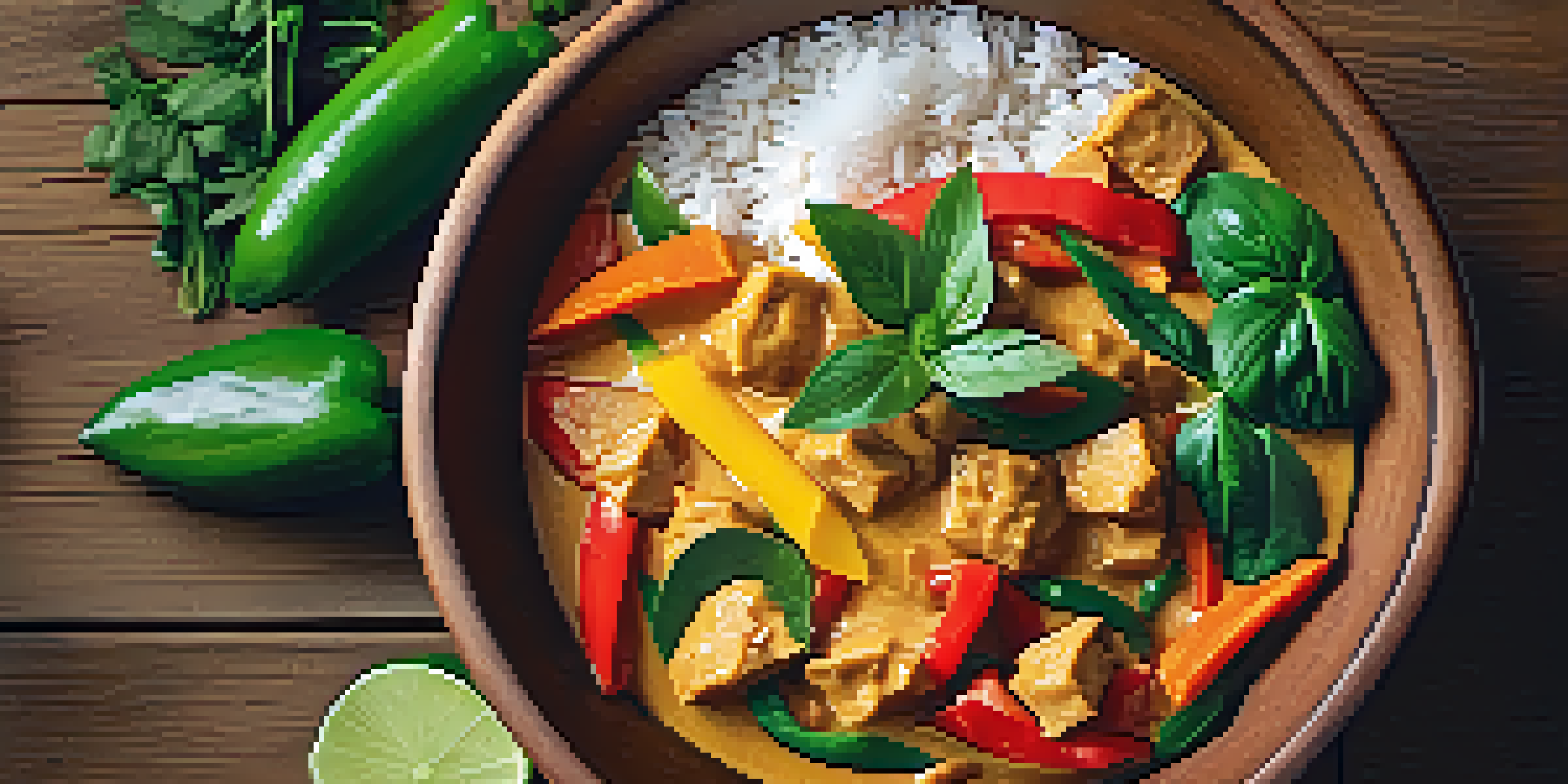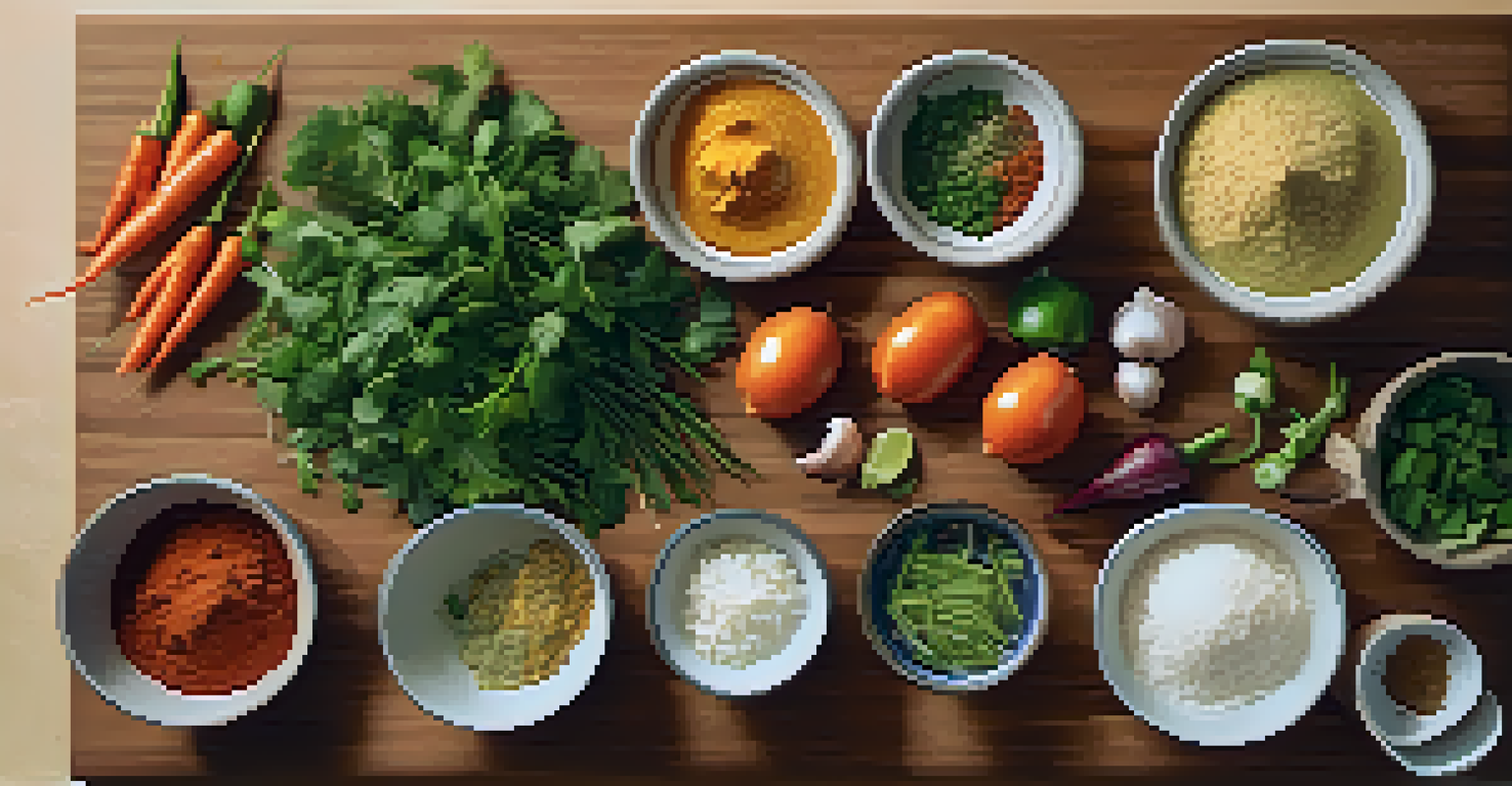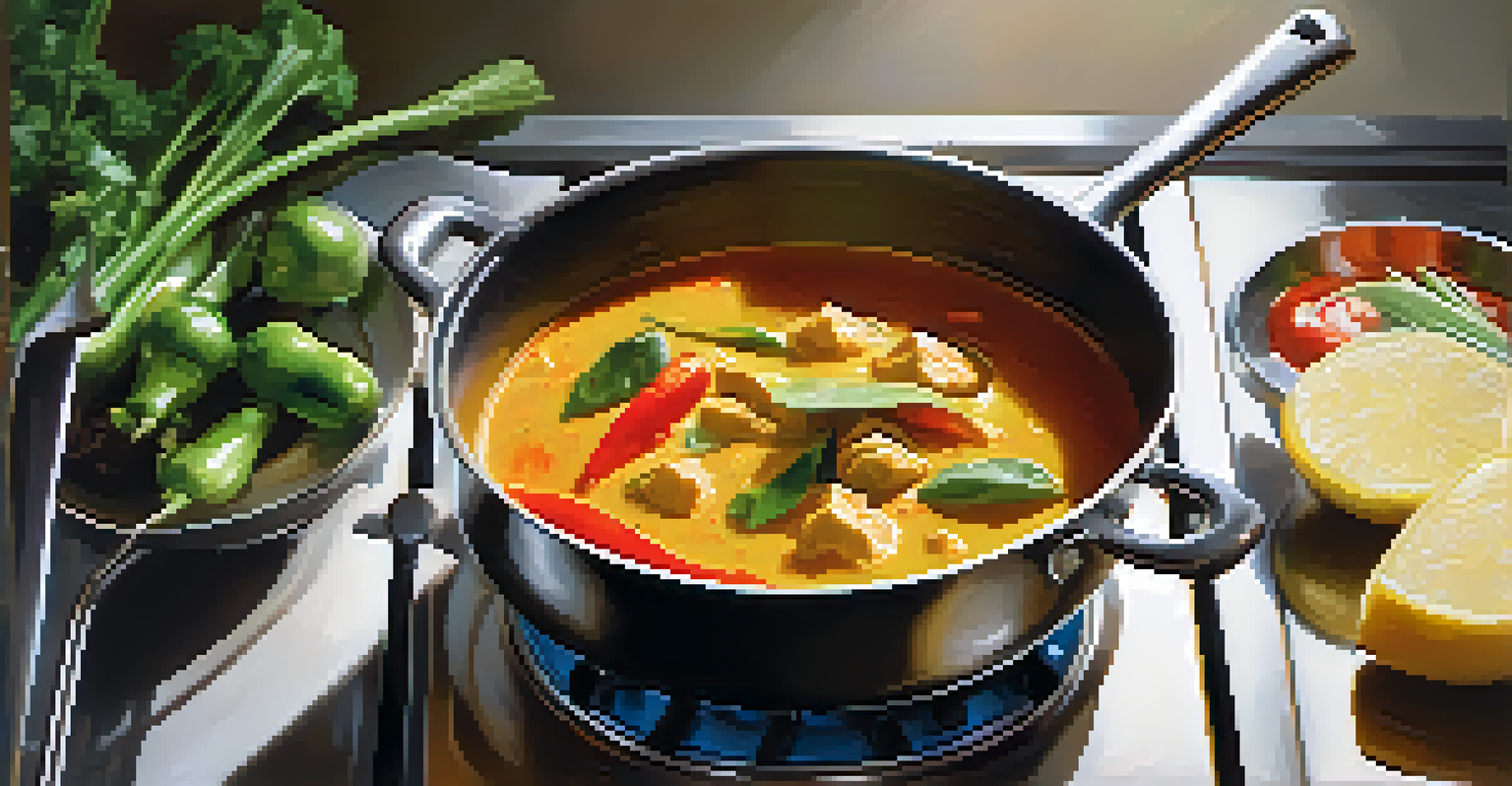Step-by-Step Guide to Cooking Thai Curry at Home

Understanding the Basics of Thai Curry
Thai curry is a vibrant and flavorful dish that showcases the balance of sweet, sour, salty, and spicy elements. Typically, it combines a protein source, vegetables, and aromatic herbs, all simmered in a creamy coconut milk base. The beauty of Thai curry lies in its versatility; you can use chicken, shrimp, tofu, or vegetables, depending on your preference.
Cooking is like love. It should be entered into with abandon or not at all.
There are several types of Thai curry, including red, green, and yellow, each defined by its unique blend of ingredients. Red curry tends to be spicier and richer due to red chilies, while green curry offers a fresh flavor profile with a hint of sweetness. Yellow curry, on the other hand, boasts a warm, earthy taste from turmeric and other spices, making it milder and perfect for those new to curry dishes.
Understanding these basics will help you choose the right type of curry for your palate. Plus, you’ll feel more confident experimenting with different ingredients and flavors, allowing you to create a dish that truly reflects your tastes.
Gathering Essential Ingredients for Thai Curry
To make a delicious Thai curry, you’ll need some essential ingredients that you can find at most grocery stores or Asian markets. Start with curry paste, which is the heart of the dish; common varieties include red, green, and yellow. Don’t forget coconut milk, which adds creaminess and balances the spices, along with a protein of your choice and seasonal vegetables for added nutrition.

Fresh herbs like basil, cilantro, and lime leaves are also crucial for enhancing the aroma and flavor of your curry. Additionally, stock or broth can help create a rich sauce, and sauces like fish sauce and soy sauce bring depth and umami. A sprinkle of sugar can also balance the flavors, ensuring your curry is well-rounded.
Thai Curry Basics Explained
Thai curry combines sweet, sour, salty, and spicy elements, with variations like red, green, and yellow offering unique flavor profiles.
Before you start cooking, take a moment to gather all your ingredients. This not only streamlines the cooking process but also allows you to focus on creating a delicious meal without any last-minute scrambles.
Preparing the Ingredients for Cooking
Once you have all your ingredients ready, the next step is prepping them for cooking. Start by chopping your chosen protein into bite-sized pieces to ensure even cooking. Then, wash and cut your vegetables into uniform sizes—this not only makes for a beautiful presentation but also ensures everything cooks evenly.
Food is symbolic of love when words are inadequate.
Don't forget to prepare your fresh herbs; tearing or chopping them just before you add them to the curry helps release their aromatic oils, enhancing the overall flavor. If you're using a store-bought curry paste, give it a quick stir to ensure the ingredients are well mixed before cooking.
Taking the time to prepare your ingredients will make the cooking process smoother and more enjoyable. Plus, it’s a great way to familiarize yourself with the textures and colors of your chosen components!
Cooking the Base for Thai Curry
To kick off your Thai curry, start by heating a bit of oil in a large pan or wok over medium heat. Once the oil is hot, add your curry paste, stirring it for a few minutes until it becomes fragrant. This step is essential, as it releases the aromatic oils from the paste and sets the foundation for a flavorful dish.
Next, you can introduce your protein to the pan, cooking it until it’s browned on the outside. This not only enhances the flavor but also helps to seal in the juices, making your curry more succulent. If you’re working with vegetables, consider adding them in stages based on their cooking times to ensure everything is perfectly cooked.
Essential Ingredients for Curry
Key ingredients for a delicious Thai curry include curry paste, coconut milk, a protein source, and fresh vegetables.
Patience is key during this stage; allowing the flavors to meld together creates a richer, more satisfying curry. Once the protein is cooked through, you’re ready to move on to the next step!
Adding Coconut Milk and Simmering
After your protein is beautifully cooked, it’s time to add the star ingredient—coconut milk! Slowly pour it into the pan, stirring gently to combine it with the curry paste and protein. This creamy addition not only thickens the curry but also balances the spices, making for a well-rounded dish.
Bring the mixture to a simmer, allowing it to bubble gently for about 10-15 minutes. This simmering stage is crucial as it allows the flavors to deepen and develop. If you find the curry too thick, feel free to add a splash of water or broth to reach your desired consistency.
As the curry simmers, take a moment to enjoy the delightful aromas wafting through your kitchen. It’s a perfect time to taste the curry and adjust the seasoning with fish sauce, sugar, or lime juice to suit your palate.
Incorporating Vegetables for Flavor and Nutrition
Once your curry has reached the perfect consistency and flavor, it’s time to add in your vegetables. Depending on the type of veggies you choose, you may need to cut them into bite-sized pieces or leave them whole for larger varieties. Adding them at this stage allows them to cook just enough to retain their crunch while soaking up the curry’s delightful flavors.
Popular choices for Thai curry include bell peppers, carrots, zucchini, and spinach, but feel free to get creative with whatever you have on hand. Stir them gently into the simmering curry, ensuring they’re evenly coated with the coconut milk and spices.
Cooking Steps for Perfect Curry
The cooking process involves sautéing curry paste, adding protein and vegetables, and simmering with coconut milk for a rich and flavorful dish.
Let the vegetables simmer for about 5-7 minutes, just until they’re tender but still vibrant. This not only adds a burst of color to your dish but also boosts its nutritional value, making your homemade curry both delicious and healthy!
Serving Your Homemade Thai Curry
At last, your Thai curry is ready to be served! Start by preparing a bed of jasmine rice or rice noodles to accompany the curry, as they’re perfect for soaking up all those flavorful juices. If you want to impress, consider garnishing your dish with fresh herbs, lime wedges, or toasted nuts for a delightful crunch.
When serving, ladle the curry over the rice or noodles, allowing the delicious sauce to cascade. This creates a visually appealing presentation that’s sure to entice everyone at the table. Don't forget to offer extra lime or chili flakes on the side for those who like a little more zing!

Enjoying your homemade Thai curry is not just about the meal itself but also about sharing it with friends and family. Gather around the table, savor the flavors, and celebrate the culinary adventure you’ve just embarked on together.